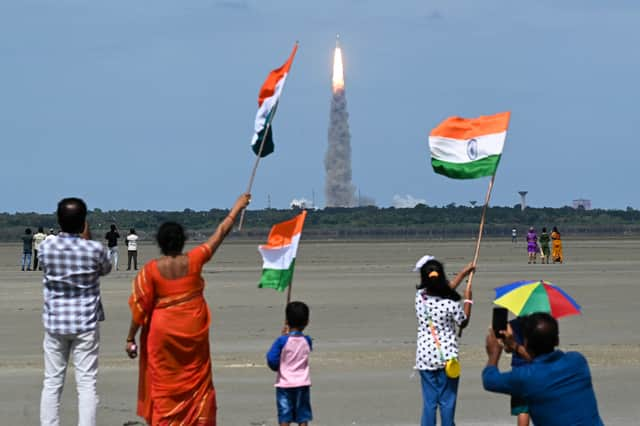Chandrayaan-3: Indian spacecraft successfully lands on the moon in a historic moment - watch the video


India's Chandrayaan-3 has successfully soft-landed on the Moon's south pole, making history for the proud nation. The country prepared for its second attempted Moon landing today, and has made history by becoming the first nation to land near the Moon's south pole - just six weeks after it launched.
India is now the fourth county to have achieved a soft landing on the Moon.
Advertisement
Hide AdAdvertisement
Hide Ad"We have a soft landing on the moon," the prime minister is told by engineers from India's Space Research Organisation.
Prime Minister Narendra Modi is addressed the Space Research Organisation and the wider world, remoting in from the BRICS summit in South Africa. He said: "This is the heartbeat of 1.4 billion people. This is the new India, the new beginning, the new thinking of the new efforts.
"This is a feature of the shine of India - we made a promise and we made it true on the surface of the moon.Today we are in space, we have proved to the world... [and] my mind and heart is on the Chandrayaan mission," he said. "This is a historic moment, and for every Indian, we are all very proud... I want to congratulate all 1.4 billion citizens of our country.
"This success belongs to all of humanity and it will help moon missions by other countries in the future."
Advertisement
Hide AdAdvertisement
Hide AdThe attempt comes just days after the Russian craft, Luna-25, crashed while attempting to land in the same region. Chandrayaan-3, a spacecraft with an orbiter, lander and a rover lifted off on 14 July from the Sriharikota space centre in south India.
The lander, which is called Vikram after Indian Space Research Organisation (Isro) founder Vikram Sarabhai, carries a 26kg rover named Pragyaan - the Sanskrit word for wisdom. Vikram began its descent today at 6:04pm Indian time (1:34 BST).
You can watch the full touchdown on NationalWorld thanks to the Indian Space Research Organisation, or directly via ISRO. Coverage began at 12:50pm BST or 5:20 p.m. IST.
When the descent began, Vikrim's speed reduced from 1.68km per second at its present height to almost zero by the time it reaches 800m, Isro's Nilesh M Desai told ANI news agency.
Advertisement
Hide AdAdvertisement
Hide AdA call was made about its landing location after the Vikram travelled down to a height of 150m. If the area was unsuitable, the lander would have had to move a little to the left or the right to find a more suitable landing spot. There was also an emergency mode in operation which would have helped with a safe landing in the worst case scenario, Mr Desai said.
Now the six-wheeled rover will emerge and roam around the rocks and craters on the Moon's surface, gathering crucial data and images to be sent to the lander, which will pass it on to the orbiter to send to Earth at a later time.
Chandrayaan-1, the country's first Moon mission in 2008, discovered the presence of water molecules on the parched lunar surface and established that the Moon has an atmosphere during daytime.
And despite failing the soft landing, Chandrayaan-2 was not a complete write-off as its orbiter continues to circle the Moon even today and will help the Vikram lander send images and data to Earth for analysis.
Comment Guidelines
National World encourages reader discussion on our stories. User feedback, insights and back-and-forth exchanges add a rich layer of context to reporting. Please review our Community Guidelines before commenting.
